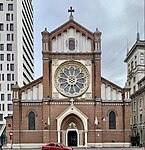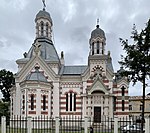Roman Catholic Archdiocese of Bucharest
1883 establishments in RomaniaAC with 0 elementsRoman Catholic dioceses in Romania

The Roman Catholic Archdiocese of Bucharest is the Latin Metropolitan archdiocese in Romania. Its cathedral episcopal see is Bucharest. Ioan Robu was the archbishop from 1990 until his retirement on 21 November 2019. He previously Apostolic Administrator since 25 October 1984. He was succeeded by Aurel Percă. Prior to his appointment, he was served as auxiliary bishop of Iaşi. .
Excerpt from the Wikipedia article Roman Catholic Archdiocese of Bucharest (License: CC BY-SA 3.0, Authors, Images).Roman Catholic Archdiocese of Bucharest
Strada General Henri Mathias Berthelot, Bucharest
Geographical coordinates (GPS) Address Nearby Places Show on map
Geographical coordinates (GPS)
| Latitude | Longitude |
|---|---|
| N 44.4421 ° | E 26.0913 ° |
Address
Catedrala romano-catolică Sfântul Iosif
Strada General Henri Mathias Berthelot
010773 Bucharest (Sector 1)
Romania
Open on Google Maps










